Federal Communications Commission
-
- Radio Technical Commission For Maritime Services Annual Meeting Maritime Reporter, Apr 1986 #90
April 2 9 — M a y 1, Boston This year's Annual Assembly Meeting of the Radio Technical Commission for Maritime Services (RTCM) will be held at the Copley Plaza Hotel in Boston, Tuesday, April 29 through Thursday, May 1.
A Welcome Reception sponsored by the RTCM Booster Club will be held at 6:30 pm on April 28 for all registrants and their spouses.
Only one formal luncheon will take place this year, at noon on April 29. Keynote speaker will be R.
Bryssinck, president of Comite International Radio Maritime.
Two historic tour programs have been planned. The bus tour on Tuesday will include highlights of Boston from Beacon Hill to the new City Hall, the waterfront area, Back Bay, Cambridge, and Faneuil Hall.
On Wednesday the tour will follow the route of Paul Revere as he warned the countryside that the British were coming. It will also include Lexington Green, where Capt. Jonathan Parker and 77 Minutemen stood their ground against 700 of England's finest regulars, and the Old North Bridge where "the embattled farmers stood and fired the shot heard around the world." On both days participants may depart the tour at either Faneuil Hall at noon or the Copley Plaza at 12:15 pm.
Tuesday, April 29 8 am to 4 pm—Registration desk open 9-10 am—Annual Business Meeting 10-10:15 am—Coffee Break 10:15-11:45 am—Session I Moderator: L.R. Raish, Fletcher, Heald & Hildreth "Survey of the National Ocean Service," by Paul M. Wolff, NOAA, U.S. Department of Commerce.
"Maritime Radio Regulation for the Eighties and Beyond," by Raymond A. Kowalski, Federal Communications Commission.
"Radionavigation Systems Know No Boundaries—The Problems of International Coordination and Planning," by David C. Scull, Research and Special Programs Administration, Department of Transportation.
" T r a n s i t i o n i n g Into the FGMDSS in the United States," by Capt. Robert E. Fenton, USCG, and Joseph D. Hersey Jr., U.S.
Coast Guard, Department of Transportation.
Noon-2:15 pm—Luncheon Keynote speaker: R. Bryssinck, president, Comite International Radio Maritime.
2:30-3:35 pm—Session II Moderator: G.F. Hempton, Federal Communications Commission.
"A Report on the April 1986 Session of the International Maritime Organization (IMO) Radiocommunications Subcommittee," by Capt.
Robert E. Fenton, USCG.
"Recent Developments for Radio Communicators and Equipment Maintainers in the Future Global Maritime Distress and Safety System (FGMDSS)," by William A.
Luther, Federal Communications Commission.
Panel Discussion on National and International Implementation of the FGMDSS.
3:35-3:50 pm—Coffee Break 3:50-5 pm—Session III Moderator: H.T. Blaker, Rockwell International.
"The New Wave—Automatic Telex, Data and Digital Selective Calling Systems," by Saverio J.
Berte, Radio-Holland U.S.A., B.V.
" N o r t h European DSC Network— Scandinavian Approach," by Goste Bengtsson, Swedish Telecom Radio.
"A Demonstration of Digital Selective Calling Equipment," by Per Thrane, Thrane & Thrane A/S, Norway, and Saverio J. Berte, Radio-Holland U.S.A.
Wednesday, April 30 8:30 am-12:30 pm—Registration desk open.
9-10:30 am—Session IV Moderator: Yaraslov Kaminsky, The Mitre Corporation.
"The 1.6 GHz Satellite EPIRB System—Preparations for Preoperational Demonstration," by Hans Kesenheimer, Dornier System GmbH, West Germany.
"Current Status and Future of the COSPAS/SARSAT System," by James T. Bailey, National Environmental Satellite Data and Information Service, NOAA, Department of Commerce.
"Interactive Distress Beacon for SARSAT," by Frederick J. Kissel, Westinghouse Electric Corporation.
"COSPAS/SARSAT SAR Performers," by Wayne A. Hembree, National Aeronautics and Space Administration, and Yaraslov Kaminsky, The Mitre Corporation.
10:30-10:45 am—Coffee Break 10:45 am-12:35 pm—Session V Moderator: J.C. Fuechsel, National Ocean Industries Association.
"INMARSAT Looks to the Future," by David W. Lipke, Communications Satellite Corporation.
"Problems and Opportunities in the Transmittal of Data Via Satcom," by George X. Tsirimokos, Sperry Corporation.
"JRC-FDMS for Use with INMARSAT System," by Kouichi Konnai, Yoshikatsu Okabe and Masanobu Okuyama, Japan Radio Company, Ltd.
"Standard C: A Low-Cost Message Handling Ship Earth Station," by John C. Bell and David C.
Schoen, International Maritime Satellite Corporation.
12:35-2:05 pm—Lunch Period, no scheduled activities.
2:05-3:15 pm—Session VI Moderator: Carl S. Andren, Racal- Megapulse, Inc.
"Capabilities of Future Radiodetermination Systems: An Analysis of Surface and Space-Based Candidates," by Keith D. McDonald, Federal Aviation Administration.
"NAVSAT in the Marine Environment," by C. Rosetti, European Space Agency.
"The Loran C System of the People's Republic of China," by the representatives of the People's Republic.
3:15-3:30 pm—Coffee Break 3:30-5 pm—Session VII Moderator: Ralph F. Eschenbach, Trimble Navigation.
"Special Committee 104 Recommendations for Differential GPS Service," by Dr. Rudolph M. Kalafus, Transportation Systems Center, Department of Transportation.
"U.S. Coast Guard Differential GPS System Development," by Lt.
Cdr. John E. Quill, USCG.
"Examining the Use of a VHF Radio Link for Transmission of Differential GPS Data," by James B.
Chadwick and Thomas B. Silli- man, Camden Instruments Corporation.
"A Differential GPS Receiver for Marine Navigation, by Dr. Alison Brown, Litton Industries.
5:45-7:45 pm—RTCM Assembly Reception for registrants and spouses.
Thursday, May 1 8:30-10:30 am—Registration desk open 9-10:30 am—Session VIII Moderator: John H. Beattie, Racal- Decca Ltd.
"The Perfect Fix—A Marriage Made in Heaven," by Patrick Patent, Racal-Megapulse, Inc.
"An Innovative Solution to Marine Radionavigation Systems Integration," by A. Ramsay, Racal- Decca Marine Navigation, Ltd., U.K.
"Maritime Racons and Transponders," by Joseph D. Hersey Jr., U.S. Coast Guard.
"Racons, Transponders and User- Selectable Services," by C. Gunnar Svala and Bo Morwing, The Ericcson Corporation, Sweden.
10:30-10:45 am—Coffee Break 10:45 am-12:15 pm—Session IX Moderator: David C. Scull, RSPA, Department of Transportation.
Panel Discussion: The Impact on Users of Government Radionavigation Policy and Plans.
12:15-1:45 pm—Lunch Period, no scheduled activities.
1:45-3:15 pm—Session X Moderator: Charles S. Carney, National Marine Electronics Association.
"Electronic Charts," by Mortimer RogofF, Navigation Sciences, Inc.
"WATERCOM—The Direct Line," by Richard A. Baker, Waterway Communications Systems, Inc.
"From Telegraphy to Teletherapy," by Steven A. Herring, PA-C, Medical Advisory Services, Inc.
"A Demonstration of the Navigation Information Network," by Bruce Seaton, Defense Mapping Agency, Department of Defense.
3:15-3:30 pm—Coffee Break 3:30-5 pm—Session XI Moderator: Martin W. Bercovici, Keller and Heckman.
"Planning NOAA Satellite Operations for the 1980s," by Daniel J.
Cotter and W. John Hussey, National Environmental Satellite Data and Information Service, NOAA, Department of Commerce.
"Update from the FCC: The Mobile Satellite and Radiodetermination Satellite Services," by John B.
Richards, Federal Communications Commission.
"The First Geostar Satellite—Initial Test Results," by Dr. Leslie O.
Snively, Geostar Corporation.
"Cellular Technology in the Offshore Environment," by Alec J.
Bentley, Gull Cellular Associates.
5-5:10 pm—Closing remarks.
For additional information on the meeting and tour programs, contact Radio Technical Commission for Maritime Services, 655 15th Street, N.W., Washington, D.C.: (202) 639- 4006.
-
- Radio Technical Commission For Maritime Services Annual Meeting Maritime Reporter, Apr 1985 #24
Break 10:30-11:45—Session I Moderator: L.R. Raish, Fletcher, Heald & Hildreth "The Changing Regulatory Environment," by Raymond A. Kowalski, U.S. Federal Communications Commission San Diego, A "Federal Government Policy on Radionavigation—What It Means to the Mariner," by David C. Scull, Research
-
- 1983 RTCM ASSEMBLY Maritime Reporter, Mar 15, 1983 #12
." The RTCM was established in 1947 as a government/industry organization under the aegis of the Department of State. In 1972, after passage of the Federal Advisory Committee Act, it became a Federal Advisory Committee chartered by the Federal Communications Commission. Today, it is structured as
-
- FCC Okays Automated Communication System For Inland Waterways Maritime Reporter, Jan 9, 1982 #13
The Federal Communications Commission recently issued a license to Waterway Communications System, Inc. (Watercom), Jeffersonville, Ind., for the construction and operation of an automated communications system serving the Mississippi, Ohio, and Illinois Rivers, and the Gulf Intracoastal Waterway.
-
- 1984 RTCM ASSEMBLY Maritime Reporter, May 15, 1984 #16
12. The RTCM was established in 1947 as a government/industry organization under the aegis of the Department of State. In 1972, after passage of the Federal Advisory Committee Act, it became a Federal Advisory Committee chartered by the Federal Communications Commission. Today, it is structured as
-
- COMSAT General Plans Expansion Of MARISAT Maritime Reporter, Apr 1977 #46
, and additional terminals are on order by industry users. COMSAT General said it will promptly seek appropriate authorization from the Federal Communications Commission to expand its MARISAT voice-grade services in the near future
-
- Tracor W i l l Develop Communications System For I n l a n d W a t e r w a ys Maritime Reporter, May 1980 #41
for an automated maritime radio communications system. D e v e l o p m e n t of the system meets a recently proposed rule of the Federal Communications Commission, which r e c o g n i z e s the need for this type of communications system network, and is planning new maritime frequency allocations
-
- MariTel Completes Field Test of Wireless DSC VHF Maritime Reporter, Jun 2001 #10
test also confirms MariTel's ability to successfully apply its marine communications business model. The company owns all nine regional Federal Communications Commission licenses to provide wireless telephone interconnect in the marine VHF radio spectrum. The company has also concluded a $31 million
-
- COMSAT President To Deliver Keynote Address At Satellite Communications Users Conference Maritime Reporter, Sep 1994 #78
from all areas of the satellite communications industry, including decision-makers from the White House, Capitol Hill, the State Department and the Federal Communications Commission, will lead discussions in different sessions. Sessions fall into one of the following four categories: User Track, Issues Tr
-
- WATERCOM Files Application For Automated Waterway Communications System Maritime Reporter, Oct 1981 #43
Waterway C o m m u n i c a t i o ns System, Inc. (WATERCOM), Arlington, Va., has filed an application with the Federal Communications Commission requesting authority to construct and operate an automated communications system serving the Mississippi, Illinois, and Ohio Rivers and the Gulf Intracoasta
-
- USCG Announces Mandatory Registration of EPIRBs Maritime Reporter, Sep 1994 #8
The U.S. Coast Guard (USCG) announced that the Federal Communications Commission (FCC) is now requiring owners of 406 MHz Emergency Position Indicating Radio Beacons (EPIRBS) to register them with the National Oceanic and Atmospheric Administration (NOAA), effective September 13. This amendment is
-
- NMEA Plans to Expand Electronics Technician Certification Program Maritime Reporter, Dec 15, 1984 #7
marine electronics equipment. According to NMEA president Gerald A. Gutman, the CMET program is expected to assume greater importance as the Federal Communications Commission (FCC) de-emphasizes its licensing activities. "Formerly, one could measure a technician's competence by the class of
-
 )
March 2024 - Marine Technology Reporter page: 45
)
March 2024 - Marine Technology Reporter page: 45ronments. The new agreement will address speci? c techni- cal gaps in the UUV defense and offshore energy markets especially for long duration, multi-payload mission opera- tions where communications are often denied or restricted. As part of the new alliance, Metron’s Resilient Mission Autonomy portfolio
-
 )
March 2024 - Marine Technology Reporter page: 40
)
March 2024 - Marine Technology Reporter page: 40NEW TECH OCEANOLOGY INTERNATIONAL 2024 All photos courtesy MTR unless otherwise noted NEW TECH, PARTNERSHIPS LAUNCH IN LONDON With Oceanology International now one month in the rear-view mirror, MTR takes a look at some of the interesting technologies launched before, during and after the London event.
-
 )
March 2024 - Marine Technology Reporter page: 23
)
March 2024 - Marine Technology Reporter page: 23elatively inactive since 2014, the Hunga Tonga–Hunga Ha‘apai (HT-HH) submarine volcano began erupting on December 20, 2021, reaching peak intensity on January 15, 2022. This triggered tsunamis throughout the Pa- R ci? c, destroyed lives and infrastructure, and generated the largest explosion recorded
-
 )
March 2024 - Marine Technology Reporter page: 14
)
March 2024 - Marine Technology Reporter page: 14TECH FEATURE TELEDYNE SLOCUM GLIDERS to hold over 3.5 times as many lithium primary batteries as the the water column and its thrusters give it the ability to stay standard Slocum Glider, and to physically accommodate up to on track in strong currents or other dif? cult ocean condi- 8 different sensor
-
 )
March 2024 - Marine Technology Reporter page: 6
)
March 2024 - Marine Technology Reporter page: 6MTR Editorial Advisors Gallaudet Hardy The Honorable Tim Gallaudet, Kevin Hardy is President PhD, Rear Admiral, U.S. of Global Ocean Design, Navy (ret) is the CEO of creating components and Ocean STL Consulting and subsystems for unmanned host of The American Blue vehicles, following a career
-
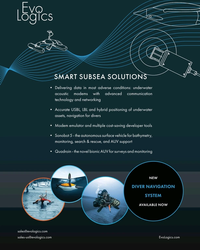 )
March 2024 - Marine Technology Reporter page: 2nd Cover
)
March 2024 - Marine Technology Reporter page: 2nd CoverSMART SUBSEA SOLUTIONS • Delivering data in most adverse conditions: underwater acoustic modems with advanced communication technology and networking • Accurate USBL, LBL and hybrid positioning of underwater assets, navigation for divers • Modem emulator and multiple cost-saving developer tools • Sonobot
-
 )
April 2024 - Maritime Reporter and Engineering News page: 43
)
April 2024 - Maritime Reporter and Engineering News page: 43“The industry is an ecosystem which includes owners, managers, mariners, shipyards, equipment makers, designers, research institutes and class societies: all of them are crucial,” – Eero Lehtovaara, Head of Regulatory & Public Affairs, ABB Marine & Ports All images courtesy ABB Marine and Ports provi
-
 )
April 2024 - Maritime Reporter and Engineering News page: 41
)
April 2024 - Maritime Reporter and Engineering News page: 41Nautel provides innovative, industry-leading solutions speci? cally designed for use in harsh maritime environments: • GMDSS/NAVTEX/NAVDAT coastal surveillance and transmission systems • Offshore NDB non-directional radio beacon systems for oil platform, support vessel & wind farm applications
-
 )
April 2024 - Maritime Reporter and Engineering News page: 28
)
April 2024 - Maritime Reporter and Engineering News page: 28FEATURE INTERVIEW track missiles and warheads for the Mis- sile Defense Agency, and it travels with its support ship, the MV Hercules. For our Service Support ships, we have the two hospital ships, USNS Mer- cy and Comfort; two rescue and salvage ships; two submarine tenders; and the Sixth Fleet ?
-
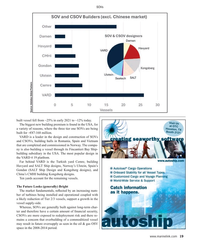 )
April 2024 - Maritime Reporter and Engineering News page: 19
)
April 2024 - Maritime Reporter and Engineering News page: 19SOVs Source: Intelatus Global Partners built vessel fell from ~25% in early 2021 to ~12% today. Visit Us The biggest new building premium is found in the USA, for at OTC Houston, TX a variety of reasons, where the three tier one SOVs are being Booth 2121 built for ~€87-168 million. VARD is a leader in
-
 )
April 2024 - Maritime Reporter and Engineering News page: 18
)
April 2024 - Maritime Reporter and Engineering News page: 18MARKETS & gas activity returns, we anticipate that supply of the vessels The Question of Emissions to offshore wind projects will reduce, driving demand for ad- Given that SOVs and CSOVs operate in a segment target- ditional CSOVs. ing reduced emissions, and many operate in the North Eu- Outside of China
-
 )
April 2024 - Maritime Reporter and Engineering News page: 16
)
April 2024 - Maritime Reporter and Engineering News page: 16MARKETS SOVs – Analyzing Current, Future Demand Drivers By Philip Lewis, Director of Research, Intelatus © Björn Wylezich/AdobeStock t a high-level, there are three solutions to transferring Lower day rate CTVs are often used for daily transfer of technicians from shore bases to offshore wind farms
-
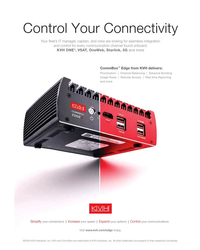 )
April 2024 - Maritime Reporter and Engineering News page: 5
)
April 2024 - Maritime Reporter and Engineering News page: 5Control Your Connectivity Your ?eet’s IT manager, captain, and crew are looking for seamless integration and control for every communication channel found onboard: ® KVH ONE , VSAT, OneWeb, Starlink, 5G and more ™ CommBox Edge from KVH delivers: Prioritization | Channel Balancing | Advance Bonding
-
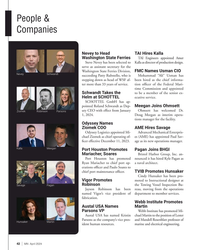 )
April 2024 - Marine News page: 42
)
April 2024 - Marine News page: 42is Mohammad “Ali” Usman has stepping down as head of WSF af- been hired as the chief informa- ter more than 33 years of service. tion of? cer of the Federal Mari- time Commission and appointed Schwandt Takes the to be a member of the senior ex- Helm at SCHOTTEL ecutive service. SCHOTTEL GmbH has ap- pointed
-
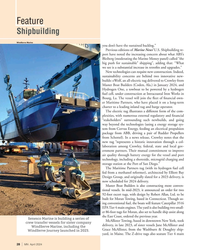 )
April 2024 - Marine News page: 28
)
April 2024 - Marine News page: 28Propellers from Schottel). In a news release, Crowley notes that the new tug “represents a historic innovation through a col- laboration among Crowley, federal, state and local gov- ernment partners. Their mutual commitment to improve air quality through battery energy for the vessel and port technology
-
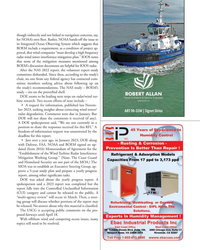 )
April 2024 - Marine News page: 25
)
April 2024 - Marine News page: 25for IOOS radar. After the NAS 2022 report, the volunteer expert study committee disbanded. Since then, according to the study’s chair, no one from any federal agency has contacted com- mittee members seeking advice about following up on the study’s recommendations. The NAS study – BOEM’s study – sits on
-
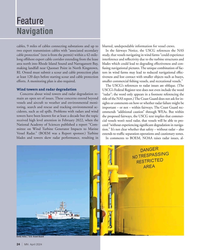 )
April 2024 - Marine News page: 24
)
April 2024 - Marine News page: 24commercial ? shing vessels, and recreational vessels.” The USCG’s references to radar issues are oblique. (The Wind towers and radar degradation USCG’s Federal Register text does not even include the word Concerns about wind towers and radar degradation re- “radar”; the word only appears in a footnote referencing
-
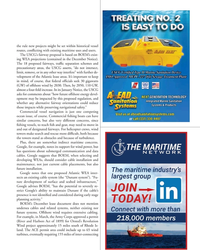 )
April 2024 - Marine News page: 23
)
April 2024 - Marine News page: 23, limit, remove, or in any other way interfere” with further de- velopment of the Atlantic lease areas. It’s important to keep in mind, of course, that federal of? cials seek 30 gigawatts (GW) of offshore wind by 2030. Then, by 2050, 110 GW, almost a four-fold increase. In its January Notice, the USCG
-
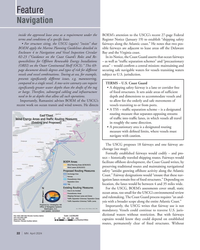 )
April 2024 - Marine News page: 22
)
April 2024 - Marine News page: 22Feature Navigation inside the approved lease area as a requirement under the BOEM’s attention to the USCG’s recent 27-page Federal terms and conditions of a speci? c lease. Register Notice (January 19) to establish “shipping safety • For structure siting, the USCG (again) “insists” that fairways along
-
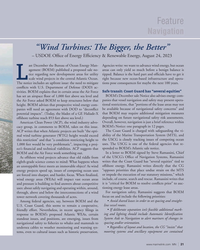 )
April 2024 - Marine News page: 21
)
April 2024 - Marine News page: 21, and this restriction” and that “a condition restricting height to the USCG is closely tracking issues of competing ocean uses. The USCG is one of the federal agencies that re- 1,000 feet would be very problematic”, impacting a proj- ect’s ? nancial and technical viabilities. ACP suggests that sponded
-
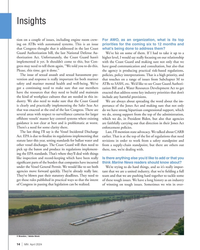 )
April 2024 - Marine News page: 14
)
April 2024 - Marine News page: 14Insights tion on a couple of issues, including engine room crew- For AWO, as an organization, what is its top ing on ATBs with automated systems. This is an issue priorities for the coming six to 12 months and that Congress thought that it addressed in the last Coast what’s being done to address them? Gua
-
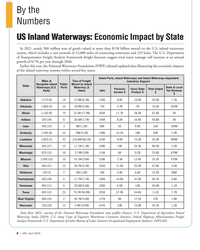 )
April 2024 - Marine News page: 8
)
April 2024 - Marine News page: 8state pro? les (Sources: U.S. Department of Agriculture Inland Waterways Study (2019); U.S. Army Corps of Engineers Waterborne Commerce Statistics; Federal Highway Administration Freight Analysis Framework; U.S. Department of Labor Bureau of Labor Statistics Occupational Employment Statistics; IMPLAN) 8
-
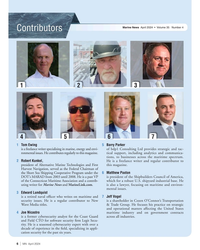 )
April 2024 - Marine News page: 6
)
April 2024 - Marine News page: 6is a freelance writer and regular contributor to president of Alternative Marine Technologies and First this magazine. Harvest Navigation, served as the Federal Chairman of the Short Sea Shipping Cooperative Program under the 6 Matthew Paxton DOT’s MARAD from 2003 until 2008. He is a past VP is president
-
 )
February 2024 - Maritime Reporter and Engineering News page: 22
)
February 2024 - Maritime Reporter and Engineering News page: 22R&D MATT HART Matt Hart, Manager & Platform Leader, Marine & Stationary Power Systems, Wabtec, offers insights on how the megatrends of decarbonization, energy transition and autonomy all inspire Image courtesy Wabtec and impact the marine power solutions from Wabtec. By Greg Trauthwein Matt, to start
